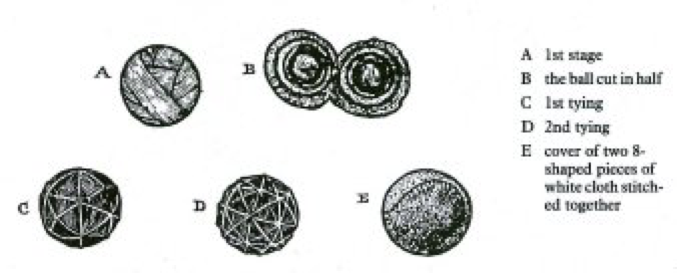The History of Tennis Balls
A real tennis ball is made by hand. As yet no synthetic version has been invented that performs acceptably on a court. The methods have changed little over the years. At the centre of the ball there is a hard kernel- originally a compacted sphere of ball cloth and nowadays a round cork which is then covered layer on layer with about ten metres of tape. This is hammered into shape in a special metal or wooden cup, then tied with thin strong string, criss-crossed and knotted once or twice. The tying is the difficult part of the operation and was originally carried out with a special instrument called a bilboquet. The tied ball is covered with two sections of yellow cloth, each cut in the shape of an eight and tightly stitched round it.
The earliest balls, known as eteufs, were made from dog-skin and stuffed with bran.

A full set of balls was traditionally 108 but at Moreton Morrell a half set of 54 balls is re-covered every week. If the string holding the ball together has slackened, the ball will have to be re-tied. All kinds of things were used to produce the inner portion of a tennis ball- a quotation from Much Ado about Nothing implies that in Shakespeare's day, tennis balls were stuffed with human hair, for Claudio says of Benedick, "The old ornament of his cheek hath already stuffed tennis balls". An injunction was introduced by Louis XI of France in 1461 to prevent unscrupulous paumiers from using dangerous but for them economic materials for stuffing, such as chalk, sand, ash and sawdust.
I freely admit to being biased but maintain after every tournament held at Moreton Morrell that the balls made by the professionals here are as good as any in the world. May they long continue to justify such an accolade?
The process of making a ball was recorded in a booklet "How to make a Real Tennis Ball", written by Richard Hamilton and illustrated by Anthony Hobson in 1977.


